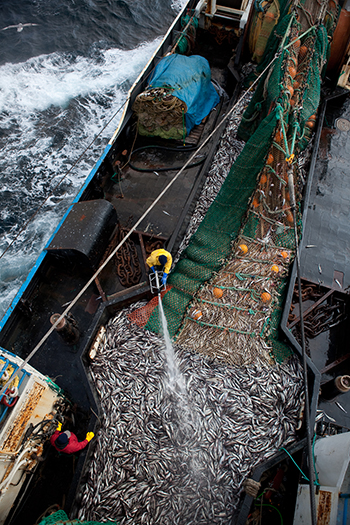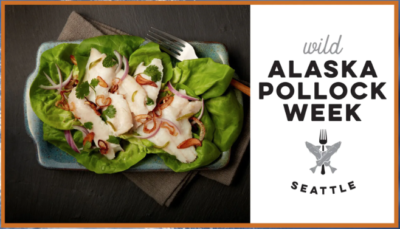I was doing a little holiday shopping with an old friend around New Year’s. She’s a pescatarian and was hoping to grab a quick bite for lunch. We were in a remote corner of the Blue Ridge Mountains in Virginia, where the options were limited to the most basic fast-food chains — my mom calls them all BurgerDoodle.
She was leaning toward the BK Impossible Whopper when I suggested the McD’s Filet-O-Fish made with wild Alaska pollock. We ordered one for everyone in the car — a first for everyone aside from yours truly — and were soon fueled up for food shopping with zero regrets. (If you haven’t had one recently, do not pass go.)
Pollock can go high-end, too. The Alaska Seafood Marketing Institute and Genuine Alaska Pollock Producers launch the first Wild Alaska Pollock Week in Seattle today, and it runs through March 8).
These celebrations, made in the image of Restaurant Weeks around the country, are a fun way to spread the word on our wild, sustainable fisheries (there’s also a Seaweed Week in Portland, Maine — April 24- May 2 — and the erstwhile Alaska Herring Week in Seattle).
Many of those fisheries’ stakeholders will also join us (and this issue) on the show floor at Seafood Expo North America in Boston, where we will undoubtedly be talking a lot about seafood marketing. In fact, a conference session on day one will convene members of the federal Marine Fisheries Advisory Committee to discuss the possibility of resurrecting the National Fish and Seafood Promotion Council.
If the question is: Do we need this again? My answer is unequivocally YES. Or at least something very similar to this.
We have watched over the last year-plus as a trade war and now coronavirus have brought some fisheries to their knees, and shuttered others entirely. The small geoduck dive fishery in Southeast Alaska shut down, likely for the whole season, because the typical $5-10-per-pound price sank to $1 with the closure of Chinese ports. That fishery reportedly sends about 90 percent of its catch to Chinese markets. A live-market product can’t rely on cold storage. Their product waits in the water, unharvested, and the fleet simply loses that income. Granted, geoducks are not a bread-and-butter fishery. But the small-scale community-based fishing lifestyle is built on the ability to string together a year-round portfolio of fishing and sundry other jobs.
So what can we do to make sure more of our fishermen are able to stay afloat when global markets can close on a dime? First, eat more seafood. I’m guessing most of the people reading this are not falling down on the job there.
Second, support a national marketing effort to promote domestic fisheries to our domestic market.
I’m talking about everything from premium live-market lobster and hand-bled pinbone-out sides of king salmon to that new 7-11 pollock sandwich and the classic Filet-o-Fish. I saw the comments from seafoods snobs about how that’s not fish. And I get it. It’s nothing like what you see when those fish hit your deck, still writhing. But it’s wild American fish that’s affordable and accessible to absolutely anyone.
Much like my pescatarian friend, the data shows that Millennials and younger generations are clamoring for real food with a story. They will pass on processed plant- and land-based proteins in favor of fish, specifically wild fish with a good story. Read more in ASMI Domestic Marketing Director Megan Rider’s Northern Lights column, “Americans are loving seafood.”
This is our domestic market. These people are looking for what we have. We just have to let them know it’s out there.








